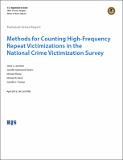| dc.contributor.author |
Janet L. Lauritsen, Jennifer Gatewood Owens, Michael Planty, Michael R. Rand, and Jennifer L. Truman |
| dc.coverage.spatial |
United States |
| dc.date.accessioned |
2016-01-07T15:27:51Z |
| dc.date.available |
2016-01-07T15:27:51Z |
| dc.identifier.uri |
http://desa1.cejamericas.org:8080/handle/2015/2833 |
| dc.description.abstract |
Findings show that while the proportion of series victimizations declined over time, the nature of these series victimizations is similar to those reported nearly two decades ago. While violent series victimizations have declined in number and proportion over time, the characteristics of these victimizations have exhibited little change. These high-rate violent victimizations tended to involve either adult violence at work, female intimate partner violence, or youth violence at school. To assess the strengths and weaknesses for enumerating and classifying series victimizations into national victimization estimates, this report examined the extent and the nature of series victimization in the National Criminal Victimization Survey (NCVS) and reviewed the general patterns and statistical properties of victims’ responses to being asked how many times the incident occurred. Series victimization analyses also examined how different treatments would affect conclusions about the victimization level and annual rate of change for various crime types and victimization characteristics. |
| dc.language.iso |
English |
| dc.title |
Methods for Counting High-Frequency Repeat Victimizations in the National Crime Victimization Survey |
| dc.ceja.source |
Fuente: United States Department of Justice |

